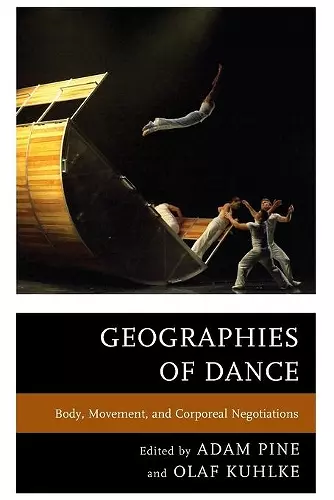Geographies of Dance
Body, Movement, and Corporeal Negotiations
Adam M Pine editor Olaf Kuhlke editor
Format:Paperback
Publisher:Bloomsbury Publishing PLC
Published:25th Aug '15
Currently unavailable, and unfortunately no date known when it will be back
This paperback is available in another edition too:
- Hardback£109.00(9780739171844)

This comprehensive examination explores the interplay between dance and geography through contributions from various disciplines, highlighting how dance transforms spaces and conveys meaning, both emotionally and symbolically, in diverse environments.
Geographies of Dance offers an in-depth exploration of the intricate relationship between dance and the spaces we occupy. This groundbreaking work features contributions from a diverse group of experts, including geographers, anthropologists, dance historians, architects, and urban planners. Together, they delve into how dance interacts with, alters, and imbues significance to the everyday environments in which we live. The book serves as both a theoretical and practical investigation into the connections between the human body, movement, and spatial contexts.
Through ten detailed case studies, Geographies of Dance illustrates the profound symbolic power of dance. It highlights how choreographers craft movements that are then brought to life by dancers, transforming various public and private spaces—such as stages, buildings, town squares, and natural landscapes—into meaningful sites of expression. Each case study provides a unique perspective on how these spaces are not merely backdrops but active participants in the dance experience.
Moreover, the book examines the emotional dimensions of dance as experienced by the dancers themselves. It emphasizes the idea that movement can convey meaning beyond words or conventional symbols, allowing for a deeper understanding of how dance resonates within different environments. By exploring these themes, Geographies of Dance enriches our appreciation of the ways in which dance shapes and is shaped by the spaces we inhabit, inviting readers to reflect on the transformative power of movement in their own lives.
The first of two proposed volumes edited by Pine and Kuhlke, this collection explores how space and place, identity and cultural diversity create embodied dance as individuals and groups negotiate the complexities of modern life. Chapter topics illustrate that people in the varied environments and sites find meaning and community through dance in different ways than one usually employs when viewing and writing about dance and dancers. Included are essays on Israeli-Jewish women's interest in belly dancing as a way to connect physicality with feminine emotions; the experiences of exotic dancers in popular strip clubs in a large city where neighborhood placement conflicts affect their ability to make a living; the evolution of jazz in Capetown, South Africa, from the 1940s swing styles and jazz era to the more current influences of hip-hop, tango, and salsa; and the work of four Toronto choreographers trained in Bharata Natyam Indian dance as they incorporate more contemporary forms to expand their cultural identities. This interdisciplinary collection offers a unique perspective on the broad role of dance in global cultures. Summing Up: Recommended. Upper-division undergraduates through faculty and professionals; general readers. * Choice Reviews *
This book shows how dance makes space effective in myriad ways. It is both a primer and, like dance, an exploration of what both the body and space can do. Anyone moving onto this rich terrain needs to start here. -- Nigel Thrift, University of Warwick
Geographies of Dance provides a valuable set of engagements with the relations, variously choreographed and creative, between dancing bodies and our understandings and experiences of space and place. Empirically rich and conceptually ambitious, the fascinating essays in this volume serve to demonstrate the vibrancy of current scholarship on this topic while also mapping out important trajectories for future research. -- Derek McCormack, University of Oxford
ISBN: 9781498520737
Dimensions: 227mm x 154mm x 19mm
Weight: 408g
264 pages